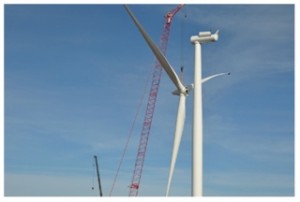Root Cause Analysis Tip: Extent of Cause … Extent of Condition

Extent of Cause / Extent of Condition
In the nuclear industry, the terms “extent of cause” and “extent of condition” are often used and misused.
But the theory of extent of cause/extent of condition goes far beyond the nuclear industry and are the reason for writing this root cause analysis tip … everyone needs to understand and apply the theory of extent of cause and extent of condition in their root cause analysis efforts.
Therefore, I will define each of the “extents” and then provide an example from the wind turbine industry.
Extent of Condition Definition
First, let’s look at extent of condition. Extent of condition evaluations are usually done soon after an accident to decide if additional immediate actions are needed to address the risk of additional failures while a root cause analysis is being conducted.
My definition of extent of condition is:
The presence of similar conditions (Causal Factors in TapRooT® terminology) across the organization.
Usually, extent of condition looks for similar equipment related conditions. For example, if a bearing fails, are similar bearings used in similar circumstances or equipment that could also fail?
Extent of condition can also be applied to human error related Causal Factors. For example, if a valve is opened accidentally, are there similar valves that might be opened accidentally?
The trick to performing an extent of condition evaluation is to decide how “similar” the condition/Causal Factor has to be. For example, on the equipment side, does the bearing have to be the identical type in exactly the same service? Evaluating this “sameness” will be a matter of engineering judgment and the risk presented by additional failures before a complete root cause analysis and corrective actions are completed.
Extent of Cause Definition
Second, let’s look at extent of cause. Extent of cause is usually performed after the specific root causes are identified for a set of Causal Factors that led to an incident/accident. The extent of cause is used to decide if a specific root cause needs to be analyzed to find the Generic Causes behind the specific root causes. This can lead to more extensive corrective actions.
My definition for extent of cause is:
The presence of similar specific root causes in other similar situations across the site/organization.
Once again, the part of this evaluation that requires judgment is … “How similar is similar?”
Real-World Example of Extent of Cause/Condition
Let’s look at a real example from the wind turbine industry to help illustrate these definitions and their use. This example is outlined in a story in Wind Power Monthly at this link:
In this example, a turbine blade failed in service. Before the root cause analysis was finished, another turbine blade of the exact type (B53) failed under very similar circumstances.
The obvious question at this point is … how extensive is the application of the B53 blade? It was found that 700 wind turbines (mostly in the US) used that blade. The manufacturer then asked users to curtail use of the affected turbines. That’s an extent of condition temporary corrective action.
The “extent of condition” in this case was limited to just the B53 blade because two of those blades had failed. However, one might ask if the manufacturer should have looked at other blades as well. Could the problem (adhesive bond failure at the attachment point for the blade) have affected other types of blades?
This example demonstrates the judgment that must be used when deciding how far is far enough when performing an extent of condition evaluation. At first, no extent of cause was considered. But when the second blade broke, an extent of cause temporary corrective action (not using turbines with this type of blade) was implemented. Perhaps if a blade of a different type had failed due to a similar condition, the temporary corrective action might have been expanded to all blades using similar technologies (perhaps beyond the B53 type).
The risk of failure (a blade falling off) was real (injury of someone being struck or property damage) but was decided to be fairly limited. Perhaps in some other industry (for example, the nuclear industry), the sensitivity to regulatory and press reaction would lead to an immediate extent of cause evaluation and an even more extensive temporary corrective action. It is all in the judgment of the evaluator and management team and their risk tolerance.
The root cause analysis of the two failures showed manufacturing problems with that particular blade type. This made the extent of cause analysis fairly easy to perform in that the manufacturing process for this type of blade was fairly unique. Thus, the corrective actions included inspections of B53 blades and repairs to any found to be delaminating because of the specific causes that had been identified.
Also, the generic corrective actions included additional safeguards in the manufacturing process to prevent future failures and an additional safeguard for current and future blades of this type to ensure the elimination of future failures. This demonstrates how extent of cause can be used to help develop corrective actions for Generic Causes.
Learn More About Root Cause Analysis
Would you like to learn more about root cause analysis and preventing failures? Then attend our 5-Day TapRooT® Advanced Root Cause Analysis Team Leader Training to learn the TapRooT® method for identifying and correcting root and generic causes. See this link for upcoming course dates around the world:
https://www.taproot.com/store/5-Day-Courses/
Or contact us by CLICKING HERE to schedule training at your site.




